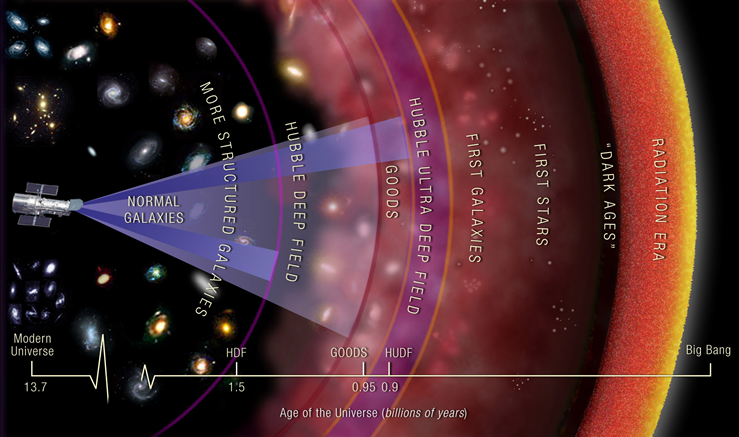29 September 2011
The Hubble Time Machine
Posted by Dan Satterfield

Because the speed of light is a constant looking at great distances is looking back in time. From HubbleSite.

You need to click the image to see it. Almost everything you see in th eimage is a galaxy consiting of billions of stars like our sun.
HubbleSite has a pretty amazing graphic up showing just how far back in time astronomers have looked using this amazing telescope and no other modern scientific instrument has captured the imagination of humans like Hubble. Eventually Hubble will burn up in the atmosphere, and that is a real shame since the most famous telescope (since Galileo made one) will be lost to history. To say that Hubble has revolutionized our understanding of the Universe would be an appalling understatement, but keep in mind that there are now ground based telescopes that have bigger light buckets and with new adaptive optic techniques, they can see some things better than Hubble.
Still, the Hubble “ultra deep field” is possibly the most amazing image ever acquired from space. Hubble stared for hour after hour at the tiniest patch of sky and collected the light from galaxies that were shining when the Universe was young. The image is made up of 800 different exposures that add up to about a million seconds of “open shutter” time! What is more incredible is just how tiny a patch of sky you are looking at.
Imagine dividing the sky into nearly 13 million tiny squares. The ultra deep field is made up of just one of them!! If you want a really big version of the UDF go here.
You might think that since we are seeing so far back toward the time of the big bang that we are looking at almost all of the Universe in that direction. This is incorrect, because we can only see light that has had time to get to our eyes and since the Universe is 13.7 billion years old, we can see no further. The current thinking of most cosmologists is that the Universe is far, far larger and perhaps infinite or nearly so. We can only see a tiny fraction of it and that is all we humans may ever see.
Furthermore, the photons of light from a galaxy that took ten billion years to travel to Earth, are showing us a galaxy that is now much further away than this. This is of course because of the expansion of the Universe (an expansion that is speeding up). We are seeing galaxies in this image that are now perhaps 20 or 30 billion light years away (I believe the exact distance is a subject of some debate). As Carl Sagan said, we are just a speck in the “great enveloping cosmic dark”….


 Dan Satterfield has worked as an on air meteorologist for 32 years in Oklahoma, Florida and Alabama. Forecasting weather is Dan's job, but all of Earth Science is his passion. This journal is where Dan writes about things he has too little time for on air. Dan blogs about peer-reviewed Earth science for Junior High level audiences and up.
Dan Satterfield has worked as an on air meteorologist for 32 years in Oklahoma, Florida and Alabama. Forecasting weather is Dan's job, but all of Earth Science is his passion. This journal is where Dan writes about things he has too little time for on air. Dan blogs about peer-reviewed Earth science for Junior High level audiences and up.
[…] La máquina del tiempo del Hubble [ENG] blogs.agu.org/wildwildscience/2011/09/29/the-hubble-time-… por tenaciousdee hace nada […]